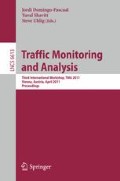Abstract
Anonymity techniques provide legitimate usage such as privacy and freedom of speech, but are also used by cyber criminals to hide themselves. In this paper, we provide usage and geo-location analysis of major anonymization systems, i.e., anonymous proxy servers, remailers, JAP, I2P and Tor. Among these systems, remailers and JAP seem to have minimal usage. We then provide a detailed analysis of Tor system by analyzing traffic through two relays. Our results indicate certain countries utilize Tor network more than others. We also analyze anonymity systems from service perspective by inspecting sources of spam e-mail and peer-to-peer clients in recent data sets. We found that proxy servers are used more than other anonymity techniques in both. We believe this is due to proxies providing basic anonymity with minimal delay compared to other systems that incur higher delays.
Access this chapter
Tax calculation will be finalised at checkout
Purchases are for personal use only
Preview
Unable to display preview. Download preview PDF.
References
I2p anonymous network, www.i2p2.de
Berthold, O., Federrath, H., Köpsell, S.: Web mixes: A system for anonymous and unobservable internet access. In: International Workshop on Designing Privacy Enhancing Technologies, pp. 115–129. Springer-Verlag New York, Inc., New York (2001)
Chaabane, A., Manils, P., Kaafar, M.: Digging into anonymous traffic: A deep analysis of the tor anonymizing network. In: 2010 4th International Conference on Network and System Security (NSS), pp. 167–174 (2010)
Chaum, D.L.: Untraceable electronic mail, return addresses, and digital pseudonyms. Commun. ACM 24(2), 84–90 (1981)
Danezis, G., Diaz, C.: A survey of anonymous communication channels (2008)
Dingledine, R., Mathewson, N., Syverson, P.: Tor: the second-generation onion router. In: SSYM 2004: Proceedings of the 13th Conference on USENIX Security Symposium, p. 21. USENIX Association, Berkeley (2004)
Edman, M., Yener, B.: On anonymity in an electronic society: A survey of anonymous communication systems. ACM Comput. Surv. 42(1), 1–35 (2009)
Feamster, N., Dingledine, R.: Location diversity in anonymity networks. In: Proceedings of the 2004 ACM Workshop on Privacy in the Electronic Society, WPES 2004, pp. 66–76. ACM, New York (2004)
Freedman, M.J., Morris, R.: Tarzan: a peer-to-peer anonymizing network layer. In: CCS 2002: Proceedings of the 9th ACM Conference on Computer and Communications Security, pp. 193–206. ACM, New York (2002)
Goldschlag, D., Reed, M., Syverson, P.: Onion routing. Communications of the ACM 42, 39–41 (1999)
Hahn, S., Loesin, K.: Privacy-preserving ways to estimate the number of tor users. Technical report, TOR project (November 2010)
Kelly, D.: A taxonomy for and analysis of anonymous communications networks. Technical report, Air Force Institute of Technology (March 2009)
Loesing, K., Murdoch, S.J., Dingledine, R.: A case study on measuring statistical data in the tor anonymity network. In: Workshop on Ethics in Computer Security Research (January 2010)
Mccoy, D., Kohno, T., Sicker, D.: Shining light in dark places: Understanding the tor network. In: Proceedings of the 8th Privacy Enhancing Technologies Symposium (2008)
Pfitzmann, A., Dresden, T., Hansen, M.: Anonymity, unlinkability, undetectability, unobservability, pseudonymity, and identity management – a consolidated proposal for terminology (2008)
Ramachandran, A., Feamster, N.: Understanding the network-level behavior of spammers. In: Proceedings of the 2006 Conference on Applications, Technologies, Architectures, and Protocols for Computer Communications, SIGCOMM 2006, pp. 291–302. ACM, New York (2006)
Reiter, M.K., Rubin, A.D.: Crowds: anonymity for web transactions. ACM Trans. Inf. Syst. Secur. 1(1), 66–92 (1998)
Reiter, M.K., Rubin, A.D.: Anonymous web transactions with crowds. Commun. ACM 42(2), 32–48 (1999)
Author information
Authors and Affiliations
Editor information
Editors and Affiliations
Rights and permissions
Copyright information
© 2011 Springer-Verlag Berlin Heidelberg
About this paper
Cite this paper
Li, B., Erdin, E., Güneş, M.H., Bebis, G., Shipley, T. (2011). An Analysis of Anonymizer Technology Usage. In: Domingo-Pascual, J., Shavitt, Y., Uhlig, S. (eds) Traffic Monitoring and Analysis. TMA 2011. Lecture Notes in Computer Science, vol 6613. Springer, Berlin, Heidelberg. https://doi.org/10.1007/978-3-642-20305-3_10
Download citation
DOI: https://doi.org/10.1007/978-3-642-20305-3_10
Publisher Name: Springer, Berlin, Heidelberg
Print ISBN: 978-3-642-20304-6
Online ISBN: 978-3-642-20305-3
eBook Packages: Computer ScienceComputer Science (R0)

